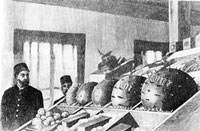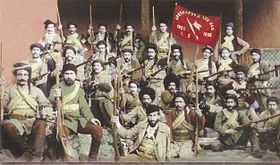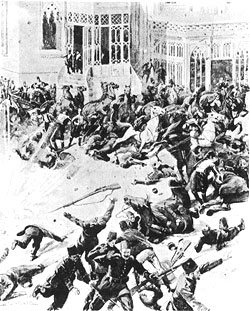I’m often asked about the history of vehicle borne improvised explosive devices, or car bombs. The book “Buda’s Wagon” posits that the first terrorist bomb of this kind was the explosion in Wall Street in 1920. But as I pointed out here, this tactic is somewhat older with the attack on Napoleon in 1800 being a classic example.
Another pre-1920 VBIED that isn’t well known was the so-called “Yildiz” assassination attack on July 21, 1905. This was an attempt by an Armenian revolutionary organization against the head of the Ottoman head of state, Abdul Hamid II, at the Yildiz Mosque in Constantinople (now Istanbul).
By 1905 Armenian left-wing revolutionaries had been fighting a long campaign against the Ottoman empire. An interesting example of previous Armenian revolutionary attacks was the 1896 Ottoman bank take-over, when Armenian revolutionaries seized the Ottoman bank headquarters in Constantinople and held its mainly western staff hostage with a mixture of pistols, grenades and IEDs. IEDs allegedly recovered from the 1896 Ottoman Bank take-over They did this in order to publicise their campaign internationally. This attack has interesting parallels with modern “Fedayeen” tactics such as the Mumbai attacks of…. Indeed the Armenian revolutionaries even referred to themselves as “fedayees”.


Armenian Revolutionaries
In 1905 the plan was to create a large IED, and a founder of the Armenian Revolutionary Federation, Christaphor Mikaelian started making explosives in Sofia, Bulgaria. During this process, Mikaelian and a comrade Kendirian were killed in an accidental explosion. Despite this, the plan for the operation continued.
The attack once again took advantage of a predictable pattern of behaviour by the target. Sultan Abdul Hamid II attended the Yidliz mosque every Friday as a matter of routine. The Armenian revolutionaries studied his movements carefully, and decided that a large device, set on a timer, hidden in a carriage outside the mosque had a good chance of succeeding.
It’s interesting that the timer, to be set by the carriage driver, was a clockwork timer of only 42 seconds, giving, in theory, just enough time for the carriage driver to leave the scene. The carriage driver, a revolutionary called Zareh, was a veteran of the Ottoman Bank take-over from 9 years earlier.
Due to an unforeseen delay the Sultan escaped injury but 26 people died, including the carriage driver Zareh.

The design of the IED in the carriage was interesting. The device was placed in a metal chest, and included 120kg of home made explosives. Other reports suggest 80kg of explosives and 20kg of iron pieces as shrapnel. I’m going to guess that the explosive used was nitroglycerine based. Beyond that details of the IED and the attack are pretty scarce, and what can be found is confused by conflicting Armenian and Turkish claims.
